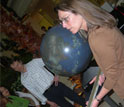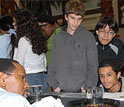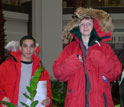|

Exhibit Descriptions

NSF FY 2009 Budget Open House
Featuring science and engineering exhibits
 |
February 4, 2008
10:00 A.M.-5:00 P.M. |
Credits: poster: Adrian Apodaca, NSF; large image: Laboratory for Computational Science and Engineering, University of Minnesota; other images: Gwen Morgan, NSF
|
Which Soccer Robot will Score? ... Make Ice Cream with Liquid Nitrogen ... Extract DNA ... plus 11 other exhibits, representing the broad range of research and education activities supported by NSF directorates and programs.
BIOLOGICAL SCIENCES (BIO)

 |
How Do They Do It? Understanding the Fastest Animal Movements Lead to Advances in Basic Science and Technology
Kiisa Nishikawa/Northern Arizona University
Location: Atrium |
In terms of force-to-weight ratio, no human-engineered devices come close to approaching the performance of animal muscles, which can produce forces up to 658 times their weight. Studies of the neuromuscular basis for extremely rapid movements in animals have led to a novel model of muscle function. The model has the potential to revolutionize the field of muscle physiology, influence the design of prostheses, and perhaps even improve the efficiency of electric motors. The exhibit features a live chameleon and toad to demonstrate their extremely rapid prey capture movements.

COMPUTER AND INFORMATION SCIENCE AND ENGINEERING (CISE)

 |
Technological Innovations from the Center for Embedded Networked Sensing
Deborah Estrin/University of California Los Angeles
Location: Room 120 |
Distributed wireless sensors embedded in the physical world, are increasingly enabling researchers to monitor and collect information on soil and air contaminants, medical patients and the structure of bridges. The Center for Embedded Networked Sensing (CENS) will have interactive displays highlighting images as sensors, participatory urban sensing and environmental sensing systems.
EDUCATION AND HUMAN RESOURCES (EHR)

 |
Georgia Partnership for Reform in Science and Mathematics (PRISM) Initiative
Jan Kettlewell/University System of Georgia
Location: Room 120 |
The Georgia Partnership for Reform in Science and Mathematics (PRISM) initiative is networking with universities and research institutions to provide challenging math and science curriculum for K-12 students. Through its Math + Science = Success campaign, PRISM is also raising public awareness of how vital math and science skills are in order for students to prosper in an science and technology driven society. The PRISM exhibit showcases two of its public service announcements, along with many tools used to guide the work of the partnership.

ENGINEERING (ENG)

 |
Biomimetic Microelectronic Systems Center
James Weiland/University of Southern California
Location: Room 110 |
The Biomimetic Microelectronics Systems Center (BMES) is revolutionizing how microelectronics interface with the human body. Interdisciplinary teams of scientists, engineers and clinicians are inventing novel engineered systems to treat severe neurological disorders. The exhibit will showcase advanced technology and basic science research targeted towards the next generation of implantable devices. Models of implants will be shown and an artificial vision simulator will be available.
GEOSCIENCES (GEO)

 |
Educational Programs and Outreach
Susan Cook/Consortium for Ocean Leadership
Location: Room 110 |
The Consortium for Ocean Leadership is a nonprofit organization that represents 95 of the leading public and private ocean research education institutions, aquaria and industry with the mission to advance research, education and sound ocean policy. The organization also manages ocean research programs in areas of scientific ocean drilling, ocean observing, ocean exploration and ocean partnerships.

OFFICE OF POLAR PROGRAMS (OPP)

 |
Thrill to Drill in the Chill
Julie Brigham-Grette/University of Massachusetts
Location: Atrium |
In 2009, a team of international scientists will drill a meteorite impact lake to recover a continuous 3.6 million-year-long record of Arctic climate change. This record will become a landmark in understanding how our climate system works and how sensitive it is to change. El’gygytgyn Crater Lake is also a perfect Earth analog to craters on Mars, thought now to have once been filled with water. Sample sediment and rock cores will be on display at the exhibit.
MATHEMATICAL AND PHYSICAL SCIENCES (MPS)

See a Digital Optical module, like one of 4800 to be deployed over 140
 |
IceCube Project
Evelyn Malkus/University of Wisconsin
Location: Room 120 |
See a Digital Optical Module, like one of 4,800 to be deployed over 1,400 meters deep below the South Pole. Watch real neutrino events detected by the already deployed modules. Try on the cold weather gear that scientists wear at the South Pole. Watch a movie of the IceCube team drilling and deploying at the South Pole. The exhibit will feature an interactive display of real events detected by IceCube using computer monitors.

SOCIAL, BEHAVIORAL AND ECONOMIC SCIENCES (SBE)

 |
How Do Organizations Learn? Keys To Competing in a Knowledge-Based World
Linda Argote/Carnegie Mellon University
Location: Room 110 |
Effective knowledge management is a source of competitive advantage for firms. Organizations that are able to retain and transfer knowledge internally, while minimizing its external leakage or spillover, are more likely to survive and prosper than those that are less adept at knowledge management. The exhibit will show evidence of these "learning curves" from organizations in both the manufacturing and service sectors. The exhibit will also provide evidence of tremendous variation in the rates at which organizations learn.
OFFICE OF INTERNATIONAL SCIENCE AND ENGINEERING (OISE)

 |
PIRE Humanoids – A U.S.-Korea Collaboration to Advance Their Capabilities
Paul Oh/Drexel University
Location: Atrium |
Humanoids are 2-legged robots engineered to mimic human form and function. Envisioned by many is a future where robots interact with people and assist in everyday chores. Such a vision demands advancing artificial intelligence and information technologies on robots. This exhibit describes an international partnership that combines engineering leadership from the United States and Korea to advance humanoids.

OFFICE OF CYBERINFRASTRUCTURE (OCI)

 |
An Open Infrastructure for Scientific Discovery
Michael Boyles/Indiana University; Scott Lathrop/University of Chicago; Melyssa Fratkin/University of Texas; Shandra Williams/Pittsburgh Supercomputing Center
Location: Room 120 |
TeraGrid is the world's largest, most comprehensive distributed cyberinfrastructure for open scientific research. Using high-performance network connections, TeraGrid integrates high-performance computers, data resources and tools and high-end experimental facilities around the country. Currently, TeraGrid resources include more than 750 teraflops of computing capability and more than 30 petabytes of online and archival data storage, with rapid access and retrieval over high-performance networks.
EXPERIMENTAL PROGRAM to STIMULATE COMPETITIVE RESEARCH (EPSCoR)

 |
Human Recognition Using Biometrics
Arun Ross/West Virginia University
Location: Room 110 |
Fingerprinting, iris scans and voice identification are all biometric measures that help with human recognition. Visitors to the West Virginia University EPSCoR exhibit will have the opportunity to interact with biometric devices that would recognize their identity. The exhibit will also feature an animation illustrating the various ongoing biometric projects at the university.

NSF EMPLOYEE DISPLAYS

 |
NSF Science Assistants Outreach Activities
Liz Lawrence/OAD
Location: Atrium |
As part of the continuing effort to involve, educate and inform the local community, volunteer staff from the National Science Foundation are hosting hands-on activities demonstrating real-world applications of science, engineering and technology. These activities, geared mainly towards children, highlight fun and interactive ways to demonstrate basic scientific principles and techniques. Learn about materials and engineering by making glue and playing with Legos! Extract DNA and find out about physical properties of liquid nitrogen! These activities, and others, will be available for discovery during this day-long exhibition.
 |
Interactive Fun in the Polar Regions
David Friscic/OPP
Location: Atrium |
Come try on the gear that scientists wear to protect themselves from sub-zero temperatures! Come see a replica of a real dinosaur skull that was discovered by scientists in Antarctica! Come walk on a map of the Arctic where researchers make their discoveries!
 |
NSF/Research.gov
Stacie Boyd/NSF
Location: Room 120 |
Research.gov is an exciting new web portal, recently released by the National Science Foundation. It provides the research community with a menu of modern grants management services, and the latest news and information for multiple federal research agencies. Visitors to the Research.gov booth will have an opportunity to try out the new site.
|


























